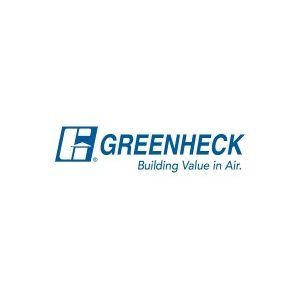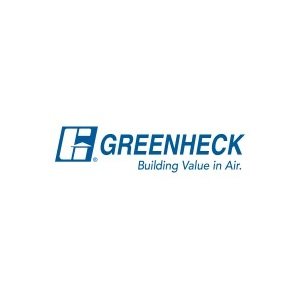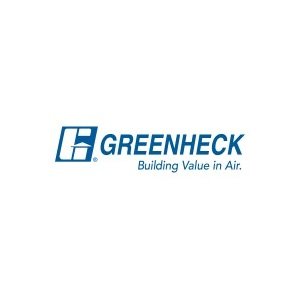Greenheck - Experts & Thought Leaders
Latest Greenheck news & announcements
Sound is a critical consideration in the selection and application of fans. Despite this, fan sound remains one of the least understood topics in the air handling industry. This series of articles provides a better understanding and point of reference on how fan sound is developed, rated, applied, and controlled. Understanding the Development of Fan Sound Data and the Product Rating Process (FA/120-23) Products that are independently third-party tested and performance certified assure the specifying engineer, installing contactor, and facility owner that the products and equipment installed will perform as stated by the manufacturer. This article provides an overview and insight into the thoroughness with which products are tested and rated for acoustic performance. The Basics of Fan Sound (FA/121-23) Fan sound values should be obtained for every fan selection and compared to available acceptance criteria up front in the design stages. This will help provide the assurance necessary for a successful application. This article discusses the nature of sound, sound terminology, different methods of rating fans for sound, and typical calculations. Radiated Sound (FA/122-23) Radiated sound is an important consideration in any low-sound application. Understanding the sources of radiated sound and available techniques for attenuating it is essential to a successful fan application. This article outlines how radiated sound is developed, rated, applied, and controlled. Sound Criteria, Attenuation Techniques, and Preventive Measures to Limit Sound Problems (FA/123-23) This article contains descriptions of the most common sound criteria and the approaches used to attenuate sound if the criteria are not satisfied. Some commonsense approaches to minimizing the likelihood of sound problems are also included.
The National Education Association cites that nearly 57.5 million students and school employees enter the doors of the nation’s schools every day. According to estimates from the U.S. Environmental Protection Agency, half of these adults and children spend their school days breathing air polluted with toxic chemicals, mold, viruses, bacteria, asbestos, pesticides, smog and particulates from vehicle pollution, and more. While the threat of severe illness from viruses such as COVID may have subsided, the need for safe and healthy indoor air has not. In addition to schools, many building spaces remain vulnerable to the negative effects of poor indoor air quality. Since the COVID pandemic, the concept of indoor air quality (IAQ) has expanded to include the concept of. Need to address Indoor Air Safety (IAS) risks Effective ventilation is the most reliable option for improving and maintaining IAS Given that most people spend 90% of their time indoors, it is more important than ever to address the Indoor Air Safety (IAS) risks associated with pathogens, wildfire smoke, and VOCs. The most reliable method for reducing threats to IAS is the multi-layered utilization of HVAC technology and products. Products that address ventilation, humidification, and filtration ultimately provide the best opportunity for assuring safe indoor air. Of these options, effective ventilation is the most reliable option for improving and maintaining IAS. In fact, the utilization of effective ventilation is the only technology solution available that mitigates CO2 and concentrations of dangerous pathogens. An effective ventilation system assures IAS in a building by accomplishing two fundamental functions: Replacing contaminated air from the building with fresh air from outside, Keeping air circulating throughout the building to prevent pollutants from accumulating in dead zones. Products that are proven effective in providing these functions include: Dedicated outdoor air system (DOAS) equipment Energy recovery ventilators Air distribution equipment Products effective in maintaining key air safety metrics These and other new products that are effective in maintaining key air safety metrics, such as relative humidity, CO2, PM2.5, and VOC levels provide the foundation for assuring IAS. While some codes set requirements for various elements of indoor air quality, related standards are in a state of ongoing development to stay current with ever-changing safety issues. For example, ASHRAE just announced the release of a brand-new standard 241, titled ‘Control of Infectious Aerosols’. This standard has yet to be ANSI approved or adopted by any codes. In the absence of established standards and code requirements, the following items provide a fundamental starting point for assuring indoor air safety levels for building occupants: CO2 — Keep CO2 levels under 1000 ppm to reduce concentrations of dangerous pathogens and improve worker productivity and student test scores; Relative humidity — 40% to 60% is the best range to mitigate the risk of pathogens and provide optimal comfort to occupants; Filtration — Use MERV 13 or higher-rated filters to achieve PM2.5 levels at or below 12 μg/m3. If the PM2.5 level goes to or above 35 μg/m3 during a 24-hour period, the air is considered unhealthy and can cause issues for people with existing breathing issues such as asthma. Using MERV 13 or higher filters will also mitigate the entrainment of wildfire smoke and related outdoor air pollutants. DOAS Rooftops are the typical location for the placement of DOAS equipment Dedicated Outdoor Air Systems or DOAS equipment can provide up to 100% of the outdoor air requirements for effective ventilation. Rooftops are the typical location for the placement of DOAS equipment, but some DOAS units have capabilities for use on the ground next to a building. Some manufacturers offer features that provide fully conditioned outdoor air and the ability to provide precision temperature and humidity control in addition to housing filters capable of reducing particle matter in the air. To help reduce heating and cooling loads associated with effective ventilation levels, some manufacturers incorporate energy-saving enthalpy wheels or cores to transfer energy from the contaminated exhaust air to the fresh supply air. Energy Recovery Equipment Energy Recovery Equipment (ERV) can often be added to existing rooftop units (RTUs) preventing the need to change out and upsize RTUs to meet new air conditioning loads associated with increased ventilation rates necessary to meet IAS requirements. The ERV reduces conditioning loads by transferring heat, cold, and humidity from the stale, contaminated exhaust air to the oxygen-rich incoming outside air. Energy recovery can offer an enthalpy recovery ratio of up to 80% and help meet requirements of standards such as ASHRAE 62.1 and 90.1. Air Distribution Equipment (GRDs) and overhead ceiling fans also play a critical role in achieving safe indoor air Grilles, registers, diffusers (GRDs), and overhead ceiling fans also play a critical role in achieving safe indoor air. These products offer an effective means of distributing air in a space, preventing stagnation and the accumulation of harmful particulates or gases in dead zones of a room. GRDs help direct air to assure effective ventilation to minimize high concentrations of contaminants. GRDs also ensure rooms maintain a constant temperature by directing airflow toward areas more affected by temperature fluctuation, such as exterior walls and windows. Overhead fans (sometimes referred to as High Volume Low Speed fans (HVLS) or Large Diameter Ceiling Fans (LDCF)) also assist in airflow distribution and direction to ensure air movement in larger areas. While helping to keep air from becoming stagnant, HVLS fans can also increase occupant comfort and reduce energy costs by reducing temperature and humidity stratification in the room. Addressing Existing Equipment and Products Designed for IAS Building owners that installed new equipment prior to the COVID pandemic may ask whether their system meets the evolving requirements for indoor air safety. This is a fair question since the investment in HVAC equipment is often significant. While many pre-COVID HVAC systems were beginning to embrace updated IAQ standards, much of the equipment in these systems may only meet minimum levels for IAQ/IAS. Older equipment that fails to meet even minimum indoor air safety requirements may need to be modified or replaced to assure safe levels of indoor air quality. Focus on space-specific IAS solutions Updating or replacing outdated equipment in an existing building can be challenging Updating or replacing outdated equipment in an existing building can be challenging. Before making updates to HVAC systems and/or equipment, designers should always verify the performance of the installed systems and components. Designers may also find it prudent to focus on space-specific IAS solutions, such as large gathering areas, classrooms, or offices rather than the entire building's HVAC system. Regardless of the type of equipment installation, it is wise to consult a qualified HVAC professional such as the local Greenheck representative, in order to help determine the best course of action to assure indoor air safety for the project. Available Grants Improving or replacing ventilation components and systems can be a large financial investment. Fortunately, federal grants are available to help offset the cost, if the situation qualifies. Grants for IAS include tax dollars from the American Rescue Plan and CARES Act. These grants are mainly for government buildings, schools, and universities. Businesses can apply for grants for energy code updates through the Inflation Reduction Act. The local Greenheck representative can help to navigate this information, too. Plan to contact them at the earliest to avail the best service.
A recently released White House Fact Sheet, Back to School 2022: Giving Every School the Tools to Prevent COVID-19 Spread and Stay Safely Open All Year Long, cites improving indoor air quality across America’s school buildings through effective ventilation and filtration as an important part of COVID-19 prevention. Proper ventilation and indoor air quality In addition to other layered prevention strategies, taking action to improve indoor air quality can also reduce the risk of exposure to particles, aerosols, and other contaminants, and improve the health of building occupants. Proper ventilation and good indoor air quality have also been shown to improve school students’ academic performance. HVAC systems Greenheck offers ventilation products for educational facilities for a safe and comfortable environment Greenheck is in a unique position to support school districts seeking to improve their heating, ventilation, and air conditioning (HVAC) systems to improve indoor air quality (IAQ) in their buildings. A manufacturer of ventilation systems for commercial and institutional buildings, Greenheck offers a complete line of ventilation products for educational facilities that create a safe, comfortable, and productive environment for students and staff while keeping operating and installation costs low. Dedicated outdoor air systems Of particular benefit to school facilities, Greenheck’s dedicated outdoor air systems (DOAS) with energy recovery provide an energy-efficient solution to bring fresh outdoor air into a building, helping to cool in the summer and heat in the winter. Energy recovery ventilators help reduce energy costs and improve indoor humidity levels by capturing energy (heat) from exhausted air to precondition (warm or cool) air before bringing it back into the building. Performance parameters A member of Air Movement and Control Association (AMCA) International, Greenheck products undergo stringent testing to adhere to the performance standards of the AMCA Certified Ratings Program ensuring products perform as specified. AMCA offers certification for 18 performance parameters, including air performance, sound, fan energy index (FEI), and leakage. Failing to meet ventilation requirements American Rescue Plan and other federal dollars may be used to make indoor air quality improvements A vast majority of school buildings in the U.S. are 20 to 50 years old and fail to meet current ventilation requirements. Likewise, many newer buildings also have technologically outdated HVAC systems or do not meet current codes. The Fact Sheet goes on to explain the American Rescue Plan and other federal dollars may be used to make indoor air quality improvements and the White House will continue to provide support to schools to help in making these improvements including connecting schools with experts to provide support for indoor air quality. improve ventilation rates In addition to helping schools plan and implement indoor air quality improvements, including through the use of federal funds, the sheet also encourages connecting schools with experts to provide support for indoor air quality. “Greenheck continues to work with school administrators, educating them on the importance of indoor air quality and solutions to improve ventilation rates and bring more fresh outdoor air into our schools,” said Mike Wolf, P.E., Greenheck director of regulatory business development. cost-effective way “Ventilation is a necessity and we need to shift the narrative from indoor air quality to indoor air safety. Moving fresh, outside air in and cycling that fresh air in a room is the quickest and most cost-effective way to remove the majority of harmful pollutants in the air.” “Additionally, it’s the only effective way to mitigate carbon dioxide levels, especially in large gathering areas holding a lot of people such as school gymnasiums and auditoriums.” Greenheck and its nationwide network of manufacturer’s representatives are ready to help schools plan and implement energy-saving indoor air quality improvements.
Leveraging Radiant And Hydronics To Help Achieve Decarbonization Goals
DownloadSealed Connectors In Harsh Environments
DownloadPowering And Cooling Next Generation Data Centers
DownloadDebunking Myths To Promote A Bright Future For Heat Pumps
DownloadOptimizing Comfort: The Ultimate HVAC Component Guide
Download




























